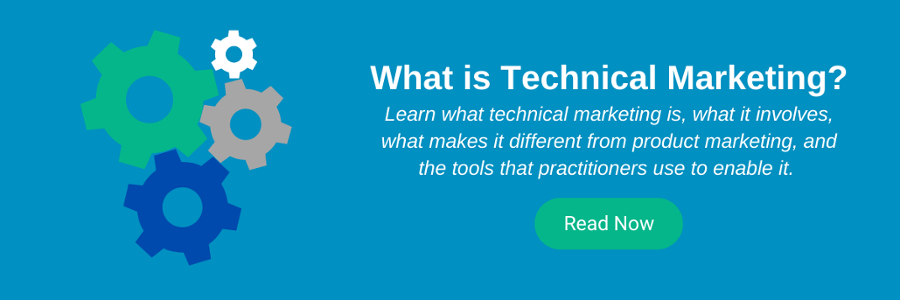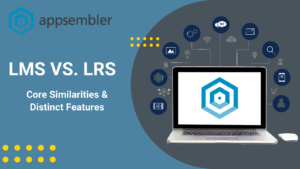A technical marketing plan shouldn’t be a copy and paste of your B2B marketing plan. Unlike most B2B marketing initiatives, technical marketing focuses on how your product works and its features rather than its benefits. The audience has different needs and the purchase journey looks very different.
According to stats, half of businesses’ IT purchases don’t go through formal approval. These purchases are often driven by tech-savvy employees or software developers who are motivated to find better solutions, purchase them for their individual use, then persuade their broader team to adopt them later. They don’t talk to salespeople or respond to traditional marketing tactics.
By creating a technical marketing plan, you will build a framework to effectively engage technical audiences, many of whom influence purchase decisions but evaluate and purchase products differently. Follow the steps below to find out how to create a technical marketing plan.
Step 1: Write Your Product’s Value Proposition
Why should your audience care about your product and why does it exist? What can it do that other products can’t? And why should anyone give you the time of day to find out more about your product?
Building a value proposition allows you to answer these questions and succinctly explain what your product does, who your product is for, why you created it, and what you offer that will make your audience’s life easier. This is also a good place to conduct market research to help you better understand your product’s competitive landscape.
Your value proposition will only consist of a few sentences or a paragraph and can change over time as your product evolves, or you can get feedback from your user base about which features they find useful or use regularly. This value proposition will underpin all you do and inform the messaging you use when promoting your product to technical audiences. It’s also useful for communicating your product’s value internally to other stakeholders or other departments.
Step 2: Identify Your Target Audience and Create a Buyer Persona
Not all technical audiences and developers are the same. You need to identify who is most likely to sign-up for and test your product and who is most likely to recommend or purchase it. The people involved will vary from business to business, but you need to narrow down your audience, rather than trying to talk to everyone all at once.
Knowing who you’re aiming your product at makes it much easier to work out how to talk to your audience. Creating a buyer persona will help you understand what makes your audience tick and what they need to engage with your product. When you go through this process, you’ll identify the characteristics of your ideal buyer, as well as what tools, techniques, channels, tone, and language you’ll use when talking to them.
After you’ve created your buyer persona(s), you can segment your audience to ensure that everything you do aligns with the characteristics of your ideal buyer. You might even run multiple campaigns at the same time to target different personas, especially as technical marketing often involves multiple stakeholders depending on where you are in the buying process.
Step 3: Define Your Goals
Tracking every marketing campaign is important, but your goals and metrics in technical marketing will differ from traditional marketing campaigns. While purchasing will be an end goal, you will initially need to focus on other areas, especially if you provide a generous free tier. These goals should be focused on measuring and improving:
- Awareness, such as social media mentions and subscribers and email newsletter sign-ups
- Adoption, such as how many applications and integrations are being built on your product,
- Engagement, such as how often are users using your product and how many features are they using
- Community, such as the number of product groups and meetings
- Satisfaction, such as your Net Promoter Score (NPS)
Since technical audiences evaluate and purchase products differently from traditional business buyers, you need to pay closer attention to the Adoption and Engagement steps in the technical buyer’s purchasing process. Adoption will tell you how effective your messaging is at capturing your buyer’s attention and convincing them to take action, but Engagement is even more important because this is where the real evaluation and purchasing decision is being made.
You might be successful at building awareness and adoption for your product, but technical audiences won’t recommend or purchase your product if its features don’t solve their problems or if the value of your features is too difficult to experience.
Step 4: Describe Your Content Initiatives and Strategies
So far, we’ve established that your technical audience has different content needs. You need to create engaging technical marketing content to help you bring your product’s value proposition to life and educate them about your product’s features, the problems it solves, and common use cases that other buyers use your product for. In short, you need to create a dedicated product education zone that speaks the language of technical audiences and gives them hands-on product training they need to decide whether or not to recommend/purchase your product.
In this step, define what kind of educational content you will create to meet these needs and work out how to position your content in a way that covers technical aspects of your product. Technical audiences want to see your features in action, try your software for themselves, and access your product documentation and code so they can decide if your product is right for them.
This type of content may clash with your company’s marketing website and tone, which is why you need to build a space that speaks directly to your technical audiences and addresses their specific needs.
You need to prepare educational content for your technical marketing zone that brings the learning experience to life. This includes:
- Product documentation
- Self-paced training
- Hands-on sandboxes
- Sample code
- Support channels (forums, support docs, or a support line)
Once you’ve decided what content to create, consider the channels you’ll use to promote it. If you’ve created a buyer persona, you’ll likely have already worked out where your audience spends most of its time. But remember to test which channels gain the most traction.
While technical marketing content is aimed at a more informed audience, remember not to assume that your audience already has certain skills and knowledge. It’s better to create content that more-informed technical buyers can skip through, rather than putting a steep learning curve in front of your audience.
Step 5: Outline Your Plan’s Contributors and Their Responsibilities
If you want your technical marketing plan to succeed, you need someone to be responsible for owning its KPIs. Instead of sharing the responsibility across different departments or leaving it in the hands of traditional marketers, assemble a team that is dedicated to technical marketing. A dedicated team will put in the necessary effort, and the required long-term time horizon, that it takes to gain the trust of your technical audience and developers.
Building a technical marketing team of subject matter experts means they can speak to the audience with the necessary authority and expertise. Your technical marketing team needs to know how to best share and explain the company’s product roadmap, source code, tutorials, and product sandboxes to developers. They also need to be the point of contact for developer feedback, feature requests, bugs, and difficulties that developers experience when using certain features. It’s a lot of responsibility for one person, which is why it’s important to break it down and share it across a dedicated team.
Step 6: Create a Community
Finally, if you want to truly engage your technical audience, you need to connect and get to know them in their world. By building a community around your product, you create a group of engaged users who can help others see the value in your product from people they trust. You also get valuable product information, such as what they find useful and easy to do with your product, what you can improve, and which features they’d like you to introduce.
Rather than trying to convert and upgrade people using your free versions through sales calls and traditional marketing tactics, help them to build a community around your product. Host events to get users together, create spaces where they can share tips with peers, and answer questions from other users.
If your company takes part in technical conversations (wherever your product’s developers are having them) and adds value as product experts and thought-leaders, you can gain the trust of developers and build a reputation for prioritizing your developers’ needs.
Don’t Expect Results Overnight
Technical marketing often requires a longer-term strategy than traditional marketing; your marketing initiatives and programs won’t achieve results overnight. Even if you create the perfect technical marketing plan, it will take time to engage your audience, especially if they aren’t initially aware of your product.
Ideally, you need to plan 12-18 months ahead and have enough time and flexibility to create and execute a plan that will help you hit your goals and set you up for success with your technical audience.
Since technical marketing takes several quarters to produce results, make sure you educate your stakeholders on its “ROI timeline” and do a thorough job of setting expectations. It’s critical that you have the runway you need to see technical marketing produce results – otherwise, your technical marketing material will go into a start-and-stop motion that will frustrate technical audiences and stunt your product’s adoption and growth.




